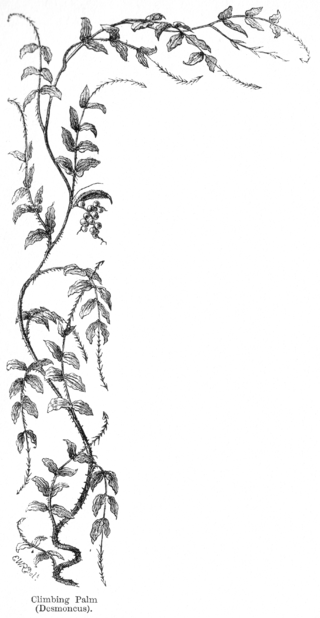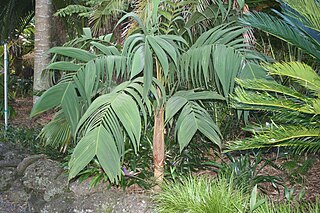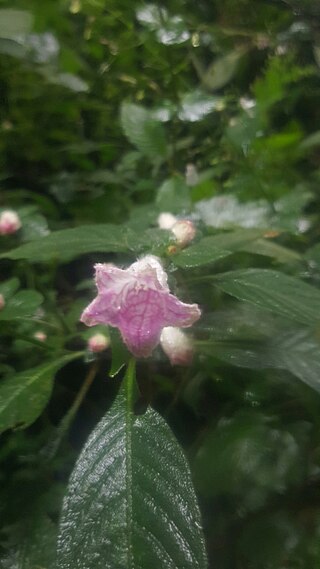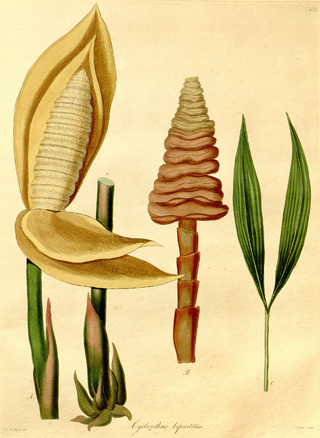
The Anacardiaceae, commonly known as the cashew family or sumac family, are a family of flowering plants, including about 83 genera with about 860 known species. Members of the Anacardiaceae bear fruits that are drupes and in some cases produce urushiol, an irritant. The Anacardiaceae include numerous genera, several of which are economically important, notably cashew, mango, Chinese lacquer tree, yellow mombin, Peruvian pepper, poison ivy, poison oak, sumac, smoke tree, marula and cuachalalate. The genus Pistacia is now included, but was previously placed in its own family, the Pistaciaceae.

Pachyrhizus is a genus of flowering plants in the legume family, Fabaceae. It includes five or species of herbs and subshrubs native to the tropical and subtropical Americas, ranging from northern Mexico to northwestern Argentina. Typical habitat is seasonally-dry tropical forest and thicket, often at forest margins, in scrub vegetation, and in open grassy areas. Plants in the genus grow from large, often edible taproots.

The Rhamnaceae are a large family of flowering plants, mostly trees, shrubs, and some vines, commonly called the buckthorn family. Rhamnaceae is included in the order Rosales.

Gnetum is a genus of gymnosperms, the sole genus in the family Gnetaceae within the Gnetophyta. They are tropical evergreen trees, shrubs and lianas. Unlike other gymnosperms, they possess vessel elements in the xylem. Some species have been proposed to have been the first plants to be insect-pollinated as their fossils occur in association with extinct pollinating scorpionflies. Molecular phylogenies based on nuclear and plastid sequences from most of the species indicate hybridization among some of the Southeast Asian species. Fossil-calibrated molecular-clocks suggest that the Gnetum lineages now found in Africa, South America and Southeast Asia are the result of ancient long-distance dispersal across seawater.

Hevea is a genus of flowering plants in the spurge family, Euphorbiaceae, with about ten members. It is also one of many names used commercially for the wood of the most economically important rubber tree, H. brasiliensis. The genus is native to tropical South America but is widely cultivated in other tropical countries and naturalized in several of them. It was first described in 1775.

Pennisetum is a widespread genus of plants in the grass family, native to tropical and warm temperate regions of the world. They are known commonly as fountaingrasses. Pennisetum is considered a synonym of Cenchrus in Kew's Plants of the World Online.

Zanthoxylum is a genus of about 250 species of deciduous and evergreen trees, shrubs and climbers in the family Rutaceae that are native to warm temperate and subtropical areas worldwide. It is the type genus of the tribe Zanthoxyleae in the subfamily Rutoideae. Several of the species have yellow heartwood, to which their generic name alludes. Several species are cultivated for their use as spices, notably including Sichuan pepper.

Zamia is a genus of cycad of the family Zamiaceae, native to North America from the United States throughout the West Indies, Central America, and South America as far south as Bolivia. The genus is considered to be the most ecologically and morphologically diverse of the cycads, and is estimated to have originated about 68.3 million years ago.

The Aponogetonaceae are a family of flowering plants in the order Alismatales.

Cyclanthaceae is a family of flowering plants.

Desmoncus is a genus of mostly climbing, spiny palms native to the Neotropics. The genus extends from Mexico in the north to Brazil and Bolivia in the south, with two species present in the southeastern Caribbean.

Geonoma is a genus of small to medium-sized palms native to the forest understorey of tropical Central and South America.

Pithecellobium is a genus of flowering plants in the family Fabaceae. It includes approximately 23 species from the tropical Americas, ranging from Mexico to Peru and northern Brazil, including the Caribbean Islands and Florida.

Cochlospermum is a genus of trees in the Bixaceae family; some classifications place this genus in the family Cochlospermaceae. It is native to tropical regions of the world, particularly Latin America, Africa, the Indian Subcontinent, and Australia.

Acanthopale is a plant genus of shrubs or subshrubs in the Acanthaceae plant family. The genus name is based on the classic Greek words for thorn ákantha and stake palum. Some species in the genus are cultivated as ornamental plants.

Cyclanthus bipartitus a species of plant in the family Cyclanthaceae, first described as a genus in 1824. It is native to southern Mexico, Central America, Trinidad, Windward Islands, northern South America.

The family Apodanthaceae comprises about 10 species of endoparasitic herbs. They live in the branches or stems of their hosts, emerging only to flower and fruit. The plants produce no green parts and do not carry out any photosynthesis. There are two genera: Pilostyles and Apodanthes. A third genus, Berlinianche, was never validly published. Mitochondrial and nuclear DNA sequences confidently place the Apodanthaceae in the Cucurbitales, where they also fit well in terms of their flower morphology. The native range of Apodanthes is restricted to Central and tropical South America, while Pilostyles has a much wider though disjointed native range, encompassing many countries in tropical and subtropical America, a section of Africa from Gabon to Tanzania and down to Zimbabwe, as well as Turkey, Iran, Iraq, and Western Australia.

Melanthera, is a genus of perennial flowering plants in the family Asteraceae, native to North and South America, as well as Africa, Asia and Oceania, including Hawaiʻi.

Cosmibuena is a genus of flowering plants in the family Rubiaceae. The genus is native to Chiapas, Central America, and South America as far south as Brazil.

Thouinia is a genus of flowering plants in the family Sapindaceae. The genus is named for André Thouin, a French botanist. As of 2020 Kew's Plants of the World Online lists 27 species in the genus:




















